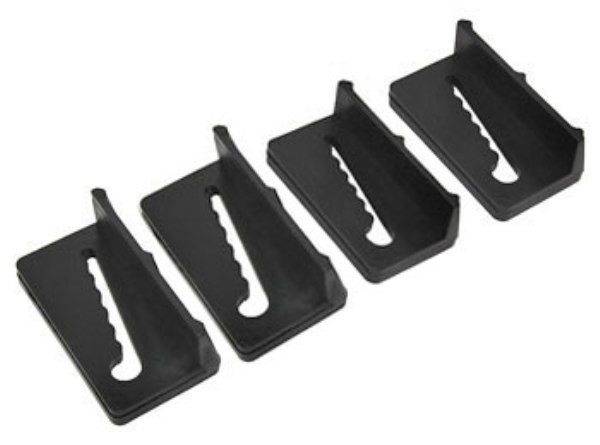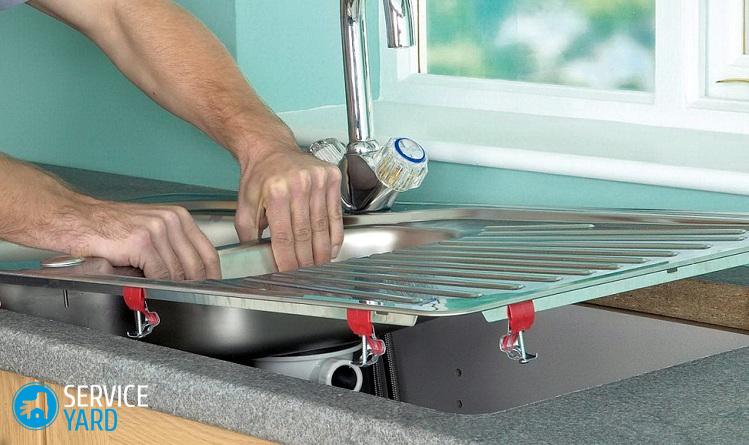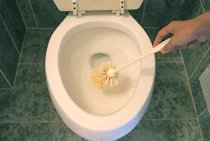Install any type of sink sink
Today, more and more people are choosing overhead sinks in the kitchen. In many ways, installing a kitchen sink on a countertop is more convenient:
-
- it cannot be torn off the mounts, even with some effort;
-
- no need to choose a suitable wall, as when installing a hinged sink;
-
- the thickness of the wall next to which the overhead sink is installed can be any;
-
- you can choose any place for installation;
-
- the surface of the table next to the sink is very convenient to use during cooking;
-
- such a sink looks very aesthetically pleasing;
-
- all connections to the sink are hidden inside the cabinet.
These advantages are slightly overshadowed by the difficulty of installation. Indeed, in order to perform a high-quality wash insert, certain skills are needed. The hole for installing the sink must be cut not only accurately, but also without damaging the surface of the table, and it is very difficult to do this without a good tool and accurate calculations. This is almost artistic wood carving.
Our experts successfully install any plumbing fixtures. We have a lot of grateful customers, and we are always glad to new customers. By inviting our specialist to connect the sink in the kitchen, you will make sure that they do not turn to us in vain. The low cost of installing a sink in the kitchen and the quality work of our craftsmen attract new customers to us.
How to install an overhead sink on a curbstone brief instructions
The overhead option for installing a kitchen sink is ordinary and “retractable”. In the latter case, the sink itself is equipped with curved slides on the side and front sides, while special grooves are provided on the nightstand. After you have successfully assembled the sink in the kitchen, it remains to push the sink into these grooves, move the structure against the wall - and you can connect communications.
If you use the direct version of surface mounting, you will have to seal all joints. A quality waterproof sealant combines the properties of an adhesive and a protective waterproof compound. The upper perimeter of the open pedestal is generously smeared with this composition, it remains to accurately place the sink itself on top.
Otherwise, one day it will fall into the cabinet along with the dishes, destroying the sewer and breaking off the water hoses under pressure. Negative impressions from such an accident will be available to both you and the neighbors below. As well as the elimination of a plumbing collapse and the repair of two rooms already from the personal budget. How to install an overhead sink on a cabinet without the danger of such an opportunity? With the help of auxiliary bars or internal crates.
It is customary to supply simple overhead sinks with additional fasteners. As such, massive bars, precisely screwed from the wrong side of the cabinet, are suitable. It is necessary to accurately mark the lower edge of the pre-installed (without glue!) Shell and build an internal crate along this line. Then the sink will rely on auxiliary bars, and not on the thin end of the nightstand. The operation is similar to the hidden installation of the crate, only in the final stage it is supplemented with adhesive sealing of the joint between metal and wood.
Sink installation diagram
Both versions of mortise and overhead sinks are mounted in cabinets with doors (rarely with drawers) that do not have a rear wall. The assembly of this element of the kitchen set has its own characteristics. They consist in the complete absence 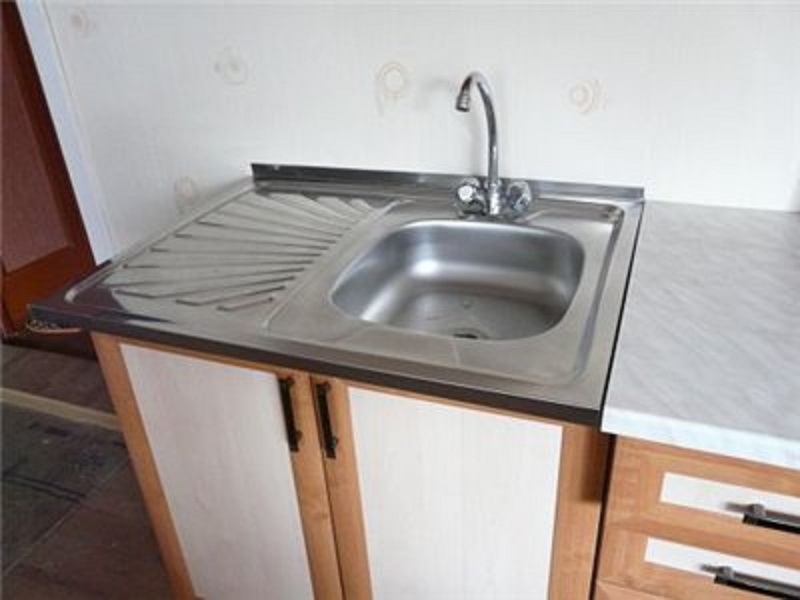
When assembling sink cabinets you should put more effort and take this piece of furniture more seriously than other cabinets. It is desirable to put it on special substrates, since there is a possibility of water leakage. It will not be superfluous to treat the cabinet itself with a special water-repellent agent. From the inside of the pedestal, it is better to provide special fasteners for tightening clamps (they are installed to strengthen the structure after the installation of the water pipe).
If the overhead sink is massive and heavy, sealing adhesive alone is indispensable. This can lead to a break in the sink and the destruction of half the kitchen. In addition, the neighbors on the floor below will suffer, since the water supply system may be damaged in the event of a break, and the water will go outside.
Overhead sinks are best reinforced with special fasteners. For these purposes, metal corners or special beams are used, which account for the main weight of the sink.
So, in order to install the kitchen sink with your own hands, you should follow a clear action plan:
- make a preliminary markup;
- determine the location of the sink;
- installation work;
- finishing work.
In order to independently perform these works, you will need the following tool:
- drill with drills;
- screwdrivers, self-tapping screws;
- pliers;
- sealant;
- pencil, ruler;
- fasteners.
In the final part of the work, when the sink is installed, as a rule, faucets, water filters (if any) and other additional structures are attached.
Installing a stainless steel kitchen sink with your own hands is not such a difficult task. It is enough to take this work seriously, prepare the necessary tools and material, and most importantly, decide in advance on the type of sink and the method of its fastening, since the peculiarity of assembling the washing cabinet will depend on this. If you are not confident in your abilities, it is better to seek help from a specialist, but you will have to pay a lot of money for this work.
https://youtube.com/watch?v=Ndnm8yp-fLs
Algorithms for self-assembly
On the wall
Wall mounting is carried out as follows:
At the selected level, we drill holes (at least 8 mm) for installing brackets.
- We hammer plastic dowels of the appropriate diameter into the holes.
- In the dowels we twist the brackets themselves, making sure that they are on the same level.
- We put the sink on the brackets, align it (the design of the mounting eyes for most models allows this) and fix it with fixing nuts.
- We attach a drain siphon and install a mixer for water supply.
- If necessary, we apply a moisture-resistant sealant to the junction of the sink and the wall.
On a cabinet without a countertop
The instruction on how to attach the overhead sink to the cabinet is also quite simple:
- From the inside, we install plastic mounting brackets, or we fasten wooden bars with metal corners.
- We apply silicone sealant to the ends of the side walls.
- We lay the sink on top, making sure that it does not move relative to the underframe.
- From the inside, we fix the sides of the sink (or special protrusions on them) with brackets. In the absence of brackets, we snap on the sides with metal corners.
- Using a screwdriver, turn the adjusting screws, securely clamping the brackets.
- Silicone that has come out from under the edge of the sink is removed with a wet hand or a clean rag.
Into the countertop
The price of sinks that are mounted in a mortise way is usually quite high. And the countertops themselves are not cheap, so inexperienced craftsmen should not take up work without preparation.
If you are confident in your abilities, then the installation should be carried out according to the following scheme:
Before attaching the sink to the countertop, we prepare a hole for installation.To do this, either the sink itself or the template that comes with it is laid on the surface. We apply markup according to the template using a marker.
- At several points on the marking line, we make holes using a wood drill. Then we connect these holes by sawing the grooves with a jigsaw.
- We process the edges of the resulting hole with a rasp, removing large burrs. After that, we apply a sealant to the cut, which will prevent the wood or MDF from swelling upon contact with moisture.
- If previously dismantled, then return the countertop to its place. Glue sealing butyl tape around the perimeter of the hole.
- We install the sink, arranging it in such a way that at least 10 mm of the side enters the entire area of \u200b\u200bthe table.
- Using regular fasteners, we fix the sink from the wrong side. For mounting on thin worktops, additional wooden blocks are usually attached.
- Additionally, we seal all joints with silicone.
Recommendations of specialists for installing a sink in the kitchen and a list of necessary tools
If you decide to mount the sink with your own hands, then it will not hurt you to familiarize yourself with a few rules explaining how and where to mount it, what tools and auxiliary materials to use, depending on what your sink is made of (stainless steel or others.) .
The first is that a sink (made of stainless steel, plastic, it doesn’t matter) should never be mounted next to an oven or refrigerator.
Secondly, the location should be close enough to the working area, since there is direct preparation for cooking (cleaning, cutting, etc.).
And finally, the third rule - the sink should divide the work area into parts. The first will be for dirty work, the second for clean work, such as serving.
As for the connection to the sewer and plumbing systems, today this does not affect the installation site, since modern technologies and the use of new building materials make it easy to choose any suitable location for the kitchen system.
Now about the tools that may be needed in the process. Here is their list:
- screwdrivers, preferably different;
- electric drill;
- electric jigsaw;
- drills for wood;
- pencil and ruler;
- pliers;
- sealant (silicone);
- sealant.
Installing and fixing the sink
Before installing a stainless steel sink on a cabinet, you need to understand that various fastening materials can be used for this. For example, the easiest way is to apply sealant to the ends of the upper frame and place the sink itself on top of it. True, we must pay tribute to this plumbing fixture, which itself can withstand decent mechanical loads, which cannot be said about sealants. After all, the sink in the kitchen is constantly subjected to shocks, displacements, vibrations. Therefore, the sealant, as a fastener, in this case is in doubt.
Someone is trying to assure that instead of sealant it is better to use mounting foam, which has a great gluing effect. No one argues with this that foam is better than sealant in terms of adhesive function, but again, there is no certainty that washing under the influence of mechanical loads and temperature changes will not fly off this type of fastener.
Therefore, experts recommend the only correct mount, which includes special fasteners in the form of brackets. Here they are in the photo below.
They are installed on the ends of the sidewalls closer to each edge. Fastening is made with a self-tapping screw. That is, it is necessary to screw in two self-tapping screws at a certain level on the inner sides of the side walls of the cabinet. The location of their installation is determined empirically. To do this, you need to install the bracket with the top shelf close to the upper end of the cabinet wall. Make a mark in the outermost slot
Please note that the brackets themselves are installed so that the slot for the screw, which is located at an angle relative to the top shelf, is located at this angle towards the door
Now, according to the marks on the sidewalls, self-tapping screws are screwed in, not completely, because you need to install brackets on them, putting them on the slot and sliding them all the way. At the same time, a gap remains between the upper shelf of the fastener and the end of the side wall, where it will be necessary to insert the seating edge of the sink itself. After that, the brackets are shifted to the stop, clamping the edge of the plumbing fixture, and the self-tapping screw is screwed in to the end, securing the bracket itself. This fastener for an overhead sink is considered the best. Anyway, it's a guaranteed mount. But before fixing the overhead sink in this way, it is recommended to treat the upper ends of the side walls of the cabinet with a sealant. This, firstly, will increase the strength of the sink, and, secondly, will create conditions for hermetic installation of the device.
There is another option that is rarely used today. This is a fastening of an overhead sink on a stand made by oneself. It can be made in the form of a crate, which is attached to the sides of the cabinet. In fact, the design itself should somewhat resemble the shape of a sink bowl. That is, the sink will be held not only on the side walls of the cabinet, but also on the fabricated frame.
What you need to install a sink
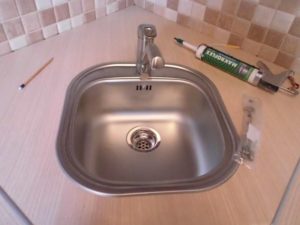
To attach the sink correctly, you need to assemble a minimum set of tools. To seal the seams, you need a silicone sealant that will protect the surface of the furniture from moisture.
Installation accessories:
- electric drill or screwdriver;
- a set of drills with a diameter for fastening;
- self-tapping screws and other products for fasteners;
- screwdrivers in a set with different sections;
- masking tape to protect furniture;
- ruler and level measuring device;
- joint sealant.
Before installation, it is recommended to clean the space and remove excess. For convenience, all communications should be fixed on the cabinet in advance. After fixing the sink, this step will be problematic. The installation location will depend on the location of the water pipes and sewerage. If space permits, then the cabinet is not recommended to be placed next to the refrigerator and heating appliances.
What determines the quality of our work
Any installation of an overhead sink begins with a study of the configuration of the template. The more complex the shape of the shell, the more effort will have to be applied to cut the corresponding hole. The slightest mistake can lead to damage to the countertop.
For a good craftsman, a high-quality installation of a mortise sink does not depend on its model, shape and material from which it is made. Today in fashion:
- round sinks made of stainless steel and stone;
- double sinks with two drains from a variety of materials;
- built-in and overhead granite sinks.
One of the popular models of sinks is a bowl made of granite chips. It looks solid, washes well, lasts a long time. Its installation is more complicated than the installation of sinks made of other materials.
If there are no holes for installing such a sink, then the cut-in of a granite sink turns into a filigree work. Sometimes there are holes, but they are too small and you have to cut them out additionally.
Our masters perfectly cope with such work, using special drills with a "diamond" crown and other tools. To determine how much it costs to install a sink in the kitchen, you need to know what material the master will have to work with.
The sink itself is quite heavy, so installing the sink into the countertop in the kitchen is done with great care so as not to drop or break expensive plumbing. More and more people are installing a convenient and practical double sink in the kitchen.
Usually it is made of stainless steel, so it is easy to clean and is not “afraid” of chips if you accidentally drop the plate into the sink. But there are other models - marble, granite or quartz. The installation of such “stone” double sinks is similar to working with a granite sink.
More and more people are installing a convenient and practical double sink in the kitchen. Usually it is made of stainless steel, so it is easy to clean and is not “afraid” of chips if you accidentally drop the plate into the sink. But there are other models - marble, granite or quartz. Installing these "stone" double sinks is similar to working with a granite sink.
Unlike a conventional sink, installation of an overhead sink with a double sink includes two drains. Such a turnkey sink is mounted by our specialists and is handed over to the owners in working condition.
No less popular is the installation of a round sink in the kitchen or in the bathroom. Like other models, it can be made from a variety of materials.
The conciseness of the geometric shape attracts attention and looks great in any interior.
The installation of any models of built-in or overhead sinks is slightly complicated by the undermount installation of the sink, because you have to work in an uncomfortable narrow space.
Before you ask how much it costs to install a kitchen sink, tell our operator which model you want to install. Having invited a specialist to install the sink, you can be sure that a qualified master will come to you.
By calling our phone and ordering any plumbing service, you will be convinced that we work not only with high quality, but also quickly. The best specialists of our company will go to fulfill your order.
How to attach a stainless steel sink to a cabinet
There are several ways to attach a sink to a cabinet:
With sealant. Apply sealant to the edges of the cabinet and place the sink on top.
How to fasten a stainless steel sink to a cabinet with fasteners?
Step-by-step instruction:
- On the inside of the cabinet, mark the places for the fasteners with a pencil.
- Screw the self-tapping screws into the marked places (not all the way).
- Fix the brackets on the screws.
- Install the sink into the grooves of the fasteners. Check if she lies flat in the place allotted to her.
- Remove the sink, turn it upside down.
- Apply sealant to the ends of the side walls.
- Coat the sink around the perimeter with silicone sealant.
- Insert the bowl into the grooves of the brackets.
- From the inside, fasten the sink with self-tapping screws.
- Remove the silicone that has come out from under the edge of the sink with a wet cloth.
- Connect water supply. Use flexible connecting hoses that allow you to move the sink away from the wall for easy installation. Connect the siphon to the drain pipe, connect the flexible hoses from the mixer to the source of hot and cold water.
- Hang the doors on the cabinet. To install the doors evenly, first screw the hinges to the doors, then attach them to the sidewall and mark the location of the hinges and their holes on the sidewalls with chalk. Screw the doors in turn, checking the coincidence of the marked location of the hinges.
Advice:
- Install an overhead sink with a mixer and a siphon already attached to it, since it will be difficult to do this after installation.
- To connect the water supply, use pipes made of metal-plastic. They are reliable, flexible and durable.
- You can fix the overhead sink in a sliding way. In this case, the cabinet must be equipped with guides, and the sink must have special curved edges. The installation of such a model is quite simple - insert the rather bent elements of the sink into the guide cabinets and push it all the way.
Assembling a cabinet for an overhead sink.
Before attaching the overhead sink to the cabinet, it still needs to be assembled. At this stage, there should be no problems: just follow the instructions. In the end, you should end up with a cabinet without a top. The back part should be with a cutout into which the communication pipes will enter: water supply and discharge. We fasten the side racks and the bottom with the help of confirmations (furniture screw for a hexagon), corners or other fasteners. Then we nail or screw the back cover.
Ready! Now put the cabinet where it will stand and you can do the washing. How to attach a countertop sink to a cabinet? First, prepare all the necessary tools.
Features of overhead sinks

- low cost;
- ease of installation of the sink.
The disadvantages include:
- relatively small thickness;
- gap between the cabinet.
Overhead models are superimposed on the cabinet and fastened. It is extremely simple to do this, especially if the height of the structures is standard.
Important. Such sinks are best suited to sets of separate modules, where the sink is not included in a single work area covered by a common worktop
Installing an overhead sink is preferable in corner kitchens. where the headset is L-shaped, and the height of the modules is standard.
